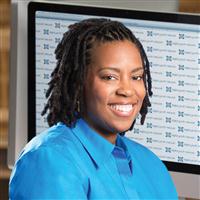
The word “literacy” traditionally has meant knowing how to read the printed word.
That definition is so last century.
Today, literacy also means having the ability to make a video, navigate online search engines, or produce a podcast. As information technology evolves from the printing press to the farthest reaches of the virtual universe, the United States must find ways to nurture learning environments that will build digitally savvy citizens for the 21st century.
So went the message of Dr. Nichole Pinkard, associate professor of computing and digital media at DePaul University, who delivered the fifth annual Dr. Lee Gurel ’48 Lecture on Dec. 3 in Tilton Hall. The lecture was co-sponsored by Clark University’s Mosakowski Institute for Public Enterprise, the Adam Institute for Urban Teaching and School Practice, and the Hiatt Center for Urban Education.
Pinkard noted that society’s definition of what it means to be literate is “inextricably tied to the technological innovations of the time,” citing new modes of communication that incorporate the visual, aural, cinematic and interactive. Today’s students must become facile in these skills, she said, because “If you’re not literate in these, you’re not prepared.”
In 2006 Pinkard founded the Digital Youth Network to help students in Chicago schools, most in low-income areas, develop technical, creative and analytical abilities that will help them thrive in a digital world.
While many young people are consumers of technology like animation, videos and graphic design, few are producers of it, which has led to a “participation gap,” Pinkard said. “If your kids aren’t producing in these media, can they occupy the jobs of the future,” she asked.
Pinkard said the challenge is to incorporate digital literacy in all the “ecosystems” of a child’s life: home, school, after school, city and nation. She has worked to fashion spaces in public schools that connect students to activities that interest them and enhance their proficiency. She described one Chicago middle school where sixth graders learn music production, seventh graders engage in digital storytelling, and eighth graders produce a digital yearbook. After school, students work on projects that they are passionate about with the assistance of mentors.
The outcomes have been positive. According to Pinkard, in one study comparing inner-city Chicago students in the Digital Youth Network with children raised in Silicon Valley, the Chicago children from sixth to eighth grade had more opportunity to create digital productions than did the Silicon Valley students. The study also showed that the Silicon Valley students learned most of their technical skills from their parents and friends, while the Chicago students learned them from their teachers and after-school mentors.
“We can create environments, spaces and ecologies that get to the same place, but do it differently,” Pinkard said.
Pinkard offered an example of how modern technologies intersect with traditional literature. Students were assigned to read Toni Morrison’s “A Mercy,” which was then used as a foundation for videos, podcasts and other methods for exploring the books structure and themes. She said the key is to expose students to these new forms of learning and connect them to overall educational goals.


